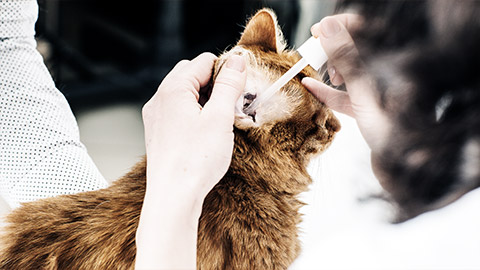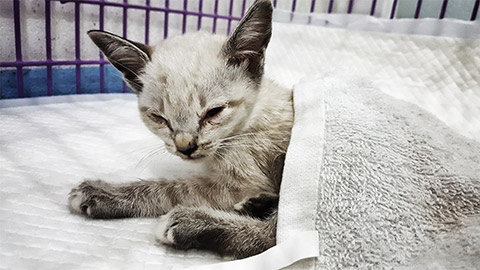There are various types of basic treatments that you may be required to administer or assist with administering, including tablets, oral medications (tablets, liquid or paste), and eye and ear drops. We’ll discuss them briefly here then return them again in detail and from a practical perspective in upcoming topic.
Certain medications and preventative treatments are administered in tablet form.
Here is a video demonstrating how to tablet a dog:
Watch: Giving your dog a tablet – Vet West Animal Hospital ( 1:15 mins)
A must see video for all pet owners and particularly useful if you are finding it stressful to give your pets tablets.
Questions
Pre Watch Question: What steps are recommended when giving your dog a tablet? Make notes.
Post Watch Task: Complete the following task using information you heard in the video. You will need to put the steps of giving a tablet in order.
Oral Paste or Liquid
Some medications come in paste or drop form. These are administered similarly to tablets. Elevate the head and place the syringe or dropper between the premolars.
Do you remember Billi the cat from the learning content on animal behaviour? Kendra, Billi’s owner, has worked with Billi on building trust around taking medication that smells bad. Obviously not all owners will have the opportunity to communicate with their companion animals like Kendra does with Billi, but the next couple of videos might give you a bit perspective on giving medicine.
Watch: How To Convince Your Cat To Take Her Medicine | BilliSpeaks (9:10 mins)
Billi’s owner Kendra has provided this background on Billi’s health condition:
“Billi is an older lady with a few chronic health issues that we juggle. She has inflammatory bowel disease (IBD) which means we have to be VERY careful with what we feed her. In particular land animals (chicken, turkey, beef) seem to be the biggest culprits. She’s well controlled on her prescription diet but finding safe things for treats/meds can be a challenge! She has polycystic kidneys which she was born with, which predisposes her to kidney disease. Two years ago she had a lifesaving surgery after getting a ureteral stone (a kidney stone that lodges in the tube that connects the kidney to the bladder) and has been doing incredibly well! Unfortunately, she’s started to have some recurrent urinary tract infections (UTI’s), which become more complicated to treat with her new “ureter” (called a SUB, or subcutaneous ureteral bypass). This is because bacteria can form a “shield” on inorganic (i.e., plastic) material that makes it harder for antibiotics to penetrate. We’ve started a new antibiotic that tastes/smells pretty horrible, and she started to refuse it. It was becoming traumatic for both of us, and I decided to change my approach. I’m still in awe that she started taking them so readily with my “explanation.” I don’t know if that’s what changed things, but the result is desirable, so I don’t really care!”
Questions
Pre Watch Question: Have you ever tried to give medication to a cat? If yes, how did it go? How did the cat respond? Was it easy?
Post Watch Task: What can people who do not have access to the keyboard system that Kendra and Billi use learn about giving medication to cats or other animals?
Watch: How To Continue To Get Your Cat To Take Medicine Even Though They’re Over It | BilliSpeaks (3:59 mins)
Billi is still needing to take the bad tasting medicine. In this video Kendra provides an update on how ‘talking’ with Billi about the medication using the keyboards is going.
Post Watch Task: Make a short list of tips for giving medication to reluctant animals. Share your list in the forum.

Ear Medication
Ear medications are used for cleaning or to treat an infection.
To administer ear medication:
- Warm the drops to room temperature.
- Elevate the ear and pull back the pinna to expose the ear canal.
- Administer the number of drops required.
- Massage gently at the base of the ear canal.
- Stand back and allow the animal to shake its head.
- Remove any excess discharge with cotton wool or gauze.
- DO NOT stick cotton tips into the ear canal.
Tip
Putting cotton tips in ears can cause the same problems for animals that they can for humans. This includes damaging the ear drum, pushing earwax further down the ear canal and risking pieces of the cotton tips falling off and becoming lodged in the ear. All of these could create the ideal conditions for an infection to set in. And of course, if your animal already has an ear problem, then the risks associated with cotton tips could make it worse rather than better.
Watch: Pet Care Basics: Rabbit Ear Medications (3:51 mins)
Learn how to administer ear drops to a rabbit.
Questions
Pre Watch Question: What are some potential problems that might occur when giving ear medication to a rabbit? Make notes as you listen.
Post Watch Task: Compare the information in the video to the bullet point list provided in the learning content above. What, if any, differences are there between the two? Is there anything specific to rabbits that you need to be aware of?
Eye Medication

Eye drops can be medicinal to treat an infection or a saline solution to act as a lubricant for dry eyes.
To administer eye drops:
- Tilt the head so the eye looks downward.
- Pull the lower lid down with your thumb to form a trough (see picture above).
- Rest the hand holding the drops on the animal's head.
- Gently administer drops and hold head for two or three seconds to ensure they don't run out of the eye.
- Gently massage the closed eye to ensure the even distribution of drops.
Watch: Pet Care Basics: How to Apply Eye Drops on Your Dog (Step-by-Step) (2:00 mins)
In this video Dr. Terah Webb demonstrates the easiest and most effective way to give a dog eye drops.
Questions
Pre Watch Question: Does Dr. Webb do any additional steps than the general steps and advice listed above in the learning content? Make notes as you watch.
Post Watch Task: Do you think this technique will work for much smaller animals? Before you watch the next video on giving eye drops to a rat, take a moment to review the steps in this video and decide if you think you would need a different approach for a guinea pig, rat or mouse.
Watch: Medicating Rat Eyes (How to) (3:58 mins)
The pet owner in this video is following the steps given to her by a vet for treating her rat’s eye issue.
Questions
Pre Watch Question: As you watch this video, compare what you see and hear to the video on giving eye drops to a dog.
Post Watch Task: Now that you have watched both videos, is there anything else you would add to the general steps given in the learning content above for applying eye treatments to different types of companion animals? Make notes for your own reference.

Preventative and maintenance health care
Several common health care treatments are routinely performed on animals to prevent health problems. These preventative treatments are typically less invasive than treating the health problem that may arise without preventative measures. Preventative health care can help prevent both infectious diseases and non-infectious health problems. We will talk more about this in an upcoming topic, where the angle will be the practical side of giving maintenance treatments to animals.
Common preventative and maintenance health care includes:
- Vaccination
- Internal parasite control, such as heartworm and intestinal worms
- External parasite control, such as mites, ticks, fleas and lice
- Nail/claw trimming and hoof care
- Dental/oral care
- Bathing, clipping and grooming
- Eye and ear cleaning
- Expressing of anal glands (EAGs)
- Providing medication for ongoing or chronic conditions.
Preventative Treatments
Preventative treatments include vaccinations, heartworm medications, and flea/parasite control. As their name suggests, these treatments are intended to prevent health problems happening rather than treat a problem once it has set in.
Things to consider before administering or recommending preventative treatments.
- Age - Many products are not suitable for use in patients under a certain age.
- Reproductive status - Some products are not suitable for use on pregnant or lactating animals.
- Pre-existing conditions - Certain products may not be suitable for use in animals that are unwell or are taking medications for other conditions.
- Breed-specific concerns - Some breeds of dogs may have sensitivities to certain drugs or treatments. One example is the Collie (both rough and smooth) and similar breeds who have inherited sensitivity to some drugs.
- Patient compliance - Some animals can be more challenging than others when it comes to administering medications, particularly tablets. When selecting products, this should be taken into consideration.
- Ease of administration - This is influenced not only by patient compliance but also by other factors. For example, older clients may not have the dexterity in their fingers to administer certain products to their companion animal. Administering treatments in the clinic may be more suitable.
- Client compliance - Treatments that require many dosages or visits to the clinic may prove to be too much for the owners and they may lapse. Consider an annual or all-in-one treatment if possible.
- Multi-pet households - Are there other animals in the house that may need to be treated?
- Cost - Some clients may be limited in their product selection due to financial constraints. Knowing the best treatments to suit every budget will help ensure client compliance.
- The geographical location of residence - Dogs with access to offal (raw organ meat) or in known hydatid areas should be wormed for hydatid tapeworm every 6 weeks. Although heartworm is less common in cats, animals residing in high-risk areas, such as near wetlands, may benefit from routine heartworm prevention.
- Indoor/outdoor animal - Indoor cats may not need to be vaccinated against FIV (Feline immunodeficiency virus) and may not need routine preventative treatment for tapeworm.
There are many 'combination' preventatives currently on the market. These products control several different parasites and should be selected based on patient status and client restrictions. It is important to be familiar with active ingredients and product guidelines to ensure the products selected are compatible and double dosing is avoided. Always follow the recommendations set by the manufacturer of the treatment.
Some products may have limitations on how they are used or sold based on their drug schedule. It’s best that Animal Care Attendant roles follow instructions provided by a vet or a vet nurse or the workplace supervisor and not make any recommendations to clients without seeking advice from an appropriate source.
Regardless of the product or product combination selected, clients should be adequately informed about the correct dosage and administration instructions. This will help to ensure the product is used correctly and the client is satisfied with the result, and therefore, your service.
Things to check include:
- the product is the correct dose for the animal for which it is intended
- the client is aware of the form of the product (liquid/tablet/paste)
- the client knows how to administer the product correctly (topical/oral)
- if the product should be administered with or without food
- if the product is water fast
- how often the product should be administered
- safety margins, including overdosage and missed doses
- any safety instructions relating to accidental human contact or exposure to fumes
- relevant disposal instructions.
Vaccination
Vaccination is the most common way to prevent infectious diseases. Most domestic animals have a recommended vaccination schedule to follow throughout their life. The specific vaccines and when they should be administered will depend on the species of animal, the individual’s life stage and risk of particular diseases.
It is generally not recommended to give vaccines during pregnancy. In particular, modified live virus vaccines should be avoided. Ideally, the female should be fully vaccinated with their core vaccines before breeding. If the standard vaccination schedule has been followed, the mother’s immunity will be able to provide adequate immunity for the offspring via colostrum in the milk (Day et al. 2016).
Vaccinations for Dogs in New Zealand
The recommended vaccination schedule for pet dogs in New Zealand generally includes a series of core and non-core vaccines. Core vaccines are essential for all dogs, while non-core vaccines are recommended based on the dog's lifestyle and risk factors. Here’s a typical vaccination schedule:
Core Vaccines
- Canine Parvovirus (CPV)
- Canine Distemper Virus (CDV)
- Infectious Canine Hepatitis (ICH)
- Canine Parainfluenza Virus (CPI)
- Leptospirosis (optional in some regions)
Non-Core Vaccines
- Kennel Cough (Bordetella bronchiseptica)
- Canine Coronavirus
- Leptospirosis (if not considered core in some areas)
Puppy Vaccination Schedule
- 6-8 weeks: First vaccination (CPV, CDV, ICH, CPI)
- 10-12 weeks: Second vaccination (CPV, CDV, ICH, CPI)
- 14-16 weeks: Third vaccination (CPV, CDV, ICH, CPI)
- 16-18 weeks: Optional Leptospirosis and Kennel Cough
Adult Dog Vaccination Schedule
- Annually: Booster for CPV, CDV, ICH, CPI (some vaccines may be given every 3 years after the initial booster)
- Annually: Leptospirosis (if part of the core vaccination in your area)
- Annually or Every 6 months:** Kennel Cough (especially for dogs that are frequently boarded or exposed to other dogs)
Vaccinations for Cats in New Zealand
The recommended vaccination schedule for pet cats in New Zealand includes core and non-core vaccines. Core vaccines are essential for all cats, while non-core vaccines depend on the cat's lifestyle and specific risk factors.
Core Vaccines
- Feline Panleukopenia (FPV)
- Feline Calicivirus (FCV)
- Feline Herpesvirus (FHV-1)
Non-Core Vaccines
- Feline Leukemia Virus (FeLV)
- Chlamydia felis
- Bordetella bronchiseptica
Kitten Vaccination Schedule
- 6-8 weeks: First vaccination (FPV, FCV, FHV-1)
- 10-12 weeks: Second vaccination (FPV, FCV, FHV-1)
- 14-16 weeks: Third vaccination (FPV, FCV, FHV-1)
- 16-18 weeks: Optional non-core vaccines (e.g., FeLV if at risk)
Adult Cat Vaccination Schedule
- Annually or Every 3 Years: Booster for FPV, FCV, FHV-1 (some vaccines may be given every 3 years after the initial series)
- Annually FeLV for at-risk cats (outdoor cats, multi-cat households)
- Annually: Chlamydia felis and Bordetella bronchiseptica if recommended by a vet
Case Study
Vaccinating Freya and Ravenna
Kai has been talking with an online friend from Australia who has a pet rabbit named Thumper, a 10-year-old Mini lop rabbit. In Australia two viruses were introduced to control populations of wild rabbits – Calicivirus and Myxomatosis. Pet rabbits are susceptible to both infectious diseases. However, it is currently illegal to vaccinate against Myxomatosis in case a vaccinated rabbit accidentally breeds with a wild rabbit and helps build immunity in the wild population. To protect Thumper from Calicivirus, Kai’s friend has had him vaccinated once a year with the Filavac VHD K C+V vaccine since Thumper was 10 weeks old. Kai thinks that Calicivirus and Myxomatosis might be an issue for domestic rabbits in New Zealand as well. They do some research online to find out if they should be vaccinating Freya and Ravenna.
Activity
Research online to find the answer that Kai is looking for. What vaccinations are recommended and available for rabbits in New Zealand? Make notes for your own reference.
Health care for different life stages
As an animal progresses through its life stages, the specific preventative and maintenance health care requirements and schedules are likely to change.
Some non-infectious health issues, such as arthritis and heart disease, are more likely in senior animals than in other life stages and so only require preventative treatment as the animal approaches that life stage.
While most vaccinations and parasite treatments are safe for pregnant and lactating animals, some medications, such as anti-inflammatories and some antibiotics and antifungals, may be harmful to either the mother or the young.
Cats and dogs are generally accepted to have the following four life stages:
- Kitten or puppy – the first 1-2 years of life is the significant growth period for these animals.
- Adult – the years when the animal is fully grown but before it begins to experience the effects of old age.
- Senior – the start of this stage depends on life expectancy. In general, the senior phase of life starts around:
- 7-9 years old in cats
- 12 years old in small dog breeds
- 10 years old in medium dogs
- 8 years old in large dogs.
- Pregnant or nursing – in the last trimester of pregnancy and in the lactation period.
You will have noticed lots more references in this module to the learning of past modules. This is because you are at the stage where you can combine all of the learning from the programme together. You are now ready to start providing solutions for issues involving the care of animals that consider ethics, legislation, health and safety, animal behaviour and handling, animal form and function all at the same time. The following case studies and activity are practice towards that. They will also help you prepare for some of the questions in assessment 05A1.
Case Study
Infection Control at Work

Today, as Emily begins her work routine at the SPCA, she receives a briefing from her supervisor about a recent increase in cat flu cases, specifically Feline Herpesvirus-1 (FHV-1) and Feline Calicivirus (FCV).
Emily has learned to spot the signs of cat flu. It's similar to a human cold but can be much more severe for our feline friends. Common symptoms include sneezing, nasal discharge, eye discharge, and sometimes even ulcers in the mouth. This morning, she noticed that Micah, a new arrival, has been sneezing frequently and has watery eyes. Emily immediately reports this to her supervisor, who confirms that Micah needs to be moved to the quarantine section.
The SPCA in Wellington has a dedicated quarantine section to manage such cases. This area is separate from the main cat housing to prevent the spread of infections. Emily knows that keeping infected cats isolated is crucial to protecting the health of other animals. She carefully transports Micah to the quarantine area, ensuring she wears gloves and a gown to avoid any contamination.
Emily is meticulous about cleaning. She knows that cat flu viruses can spread through direct contact with an infected cat or contaminated surfaces. In the quarantine section, she follows strict cleaning protocols. She disinfects all surfaces, including Micah’s cage, food bowls, and litter box, with an antiviral cleaner approved by the SPCA. Emily also changes her gloves and washes her hands thoroughly after handling anything in the quarantine section.
The SPCA has clear policies and procedures for infection control. Emily and her colleagues receive regular training to stay updated on the best practices. These policies include:
- Immediate isolation of any cat showing symptoms of infectious diseases.
- Use of personal protective equipment (PPE) such as gloves and gowns.
- Thorough cleaning and disinfection of all areas, especially the quarantine section.
- Regular health checks and vaccination updates for all animals.
Emily understands the importance of communication in managing cat flu outbreaks. She keeps detailed records of Micah’s symptoms, treatments, and progress, which helps the veterinary team provide the best care. Additionally, she updates her team about the health status of all cats in quarantine during their daily briefings.
Case Study
Identifying and Managing Potential Health Issues

Today, a new client brings in Boysie, a recently adopted dog that looks a bit shabby. Caleb greets them with a smile.
Caleb: "Mōrena! You must be Feroz, and this handsome guy is Boysie. How can I help you today?"
Feroz: "Yes, that's right. I just adopted Boysie, and he needs a good grooming. He looks a bit rough, and I'm hoping you can help clean him up."
Caleb immediately notices that Boysie has some patches of missing fur and is scratching a lot. His professional development training kicks in.
Caleb: "Sure, I can definitely help with that. I see Boysie has some areas with missing fur and seems quite itchy. Do you know if he has any health issues or if he's been scratching a lot?"
Feroz: "Yeah, he's been scratching a lot lately. I adopted him from someone I found on social media, not from a breeder or a rescue. I'm not sure about his health history."
Caleb knows that skin conditions can be tricky. They could be allergies, flea infestations, or even zoonotic diseases like scabies, which can be transmitted to humans.
Caleb: "It's great that you adopted Boysie. The scratching and fur loss could be due to several things like allergies, fleas, or even something contagious like scabies. It's hard to tell just by looking."
Feroz: "Scabies? That sounds serious. What should I do?"
Caleb: "First, I recommend taking Boysie to a vet for a thorough check-up. They can do tests to figure out exactly what's causing his symptoms. In the meantime, I can give him a gentle bath with a medicated shampoo that might help relieve some of the itching. But without knowing the cause, it’s best to get a professional opinion."
Feroz: "Thanks for the advice, Caleb. I didn’t realize it could be something serious. I'll definitely take him to the vet."
Caleb proceeds with caution, using gloves while handling Boysie to prevent any potential spread of a zoonotic condition. He uses a gentle, hypoallergenic shampoo to avoid aggravating Boysie’s skin further.
Caleb: "I'll give Boysie a gentle bath today, and I'll avoid any harsh grooming techniques until we know more about his condition. Make sure to let the vet know about his symptoms and where he came from; it can help with the diagnosis."
Case Study
Zoe’s Dilemma: Sheep

Today, Zoe is excited to check out another new location for her doggie clients to explore.
As Zoe arrives at the new walking spot, she notices that sheep have been grazing in the area. This immediately raises a red flag for her. She knows that sheep can be intermediate hosts for zoonotic diseases and can carry parasites that might infect dogs.
Zoe stops and takes a moment to think. She considers the potential risks of letting the dogs roam in an area where sheep have recently been and recalls her training and the importance of preventing the spread of zoonotic diseases. Ultimately, she decides to find an alternative location for today's walk. She knows that keeping her clients' dogs safe is her top priority.
She drives to a nearby park that she knows is safe and free from potential contamination. During the walk, she keeps a close eye on the dogs, ensuring they are healthy and happy.
Later, Zoe sends a message to her clients to inform them about the decision she made and why.
"Hi everyone, just wanted to let you know that I decided to take the dogs to the park today instead of the new location I mentioned in my email yesterday. There were sheep grazing there, and I didn't want to risk any potential health issues. Safety first!"
Case Study
Choosing Pets for Immunocompromised Individuals

Today, a family enters Aroha’s shop looking for advice on choosing a pet bird. They mention that one family member is immunocompromised, which raises some important considerations.
Aroha greets the family with a warm smile. "Kia ora! How can I help you today?"
Parent: "Hello! We're thinking about getting a pet bird, maybe a parrot or a canary. But we need to be cautious because one of our family members has a weakened immune system."
Aroha immediately thinks about the potential risks associated with pet birds, especially regarding zoonotic diseases.
Aroha: "It's great that you're considering a pet bird. However, it's important to know that birds can carry diseases like salmonella that might pose a risk to someone with a compromised immune system.”
Parent: "Oh, I didn't know that. Is it something that all birds carry?"
Aroha: "Not all birds carry it, but it can be an issue in parrots and canaries, as well as wild birds. Immunocompromised people are more susceptible to infections, so it's something to consider seriously. If you're set on getting a bird, it's essential to ensure the bird is healthy and has been screened for any diseases. Regular veterinary check-ups are a must. Alternatively, you might want to consider other pets that are less likely to carry zoonotic diseases."
Parent: "What pets would you recommend?"
Aroha: "Fish are a great option because they don't carry diseases that can be transmitted to humans. They can be soothing to watch and relatively easy to care for. Depending on the needs of your family member you may also consider adopting an older rescue cat or dog that has received all of their vaccinations and had regular veterinary check-ups. Cats and dogs can still transmit diseases to humans, but if they are older, rather than a kitten or puppy, and they are in good health they may be a lower risk to their human owners.
Parent: "You've given us a lot to think about."
Aroha: "Here's some more information about zoonotic diseases and pet care tips. It's always a good idea to consult with a vet before making a decision. They can provide specific advice tailored to your situation."
Parent: "Thank you so much, Aroha."
Aroha: "You're welcome! I'm glad I could help.”
Case Study
Kai's Itchy, Red Arm

Despite their social anxiety, Kai has been making an effort to interact with other rabbit enthusiasts by volunteering at a local rabbit rescue.
One evening after a shift at the rabbit rescue, Kai notices something unusual. There's a strange, itchy, almost perfectly round marking on their arm. Their knowledge about zoonotic diseases immediately makes them cautious.
Kai shows their mum: "This mark looks weird. I hope it's nothing serious. It doesn't look like a regular bug bite."
Mum: “Get it checked out.”
Kai's mind races through possibilities, recalling their studies about zoonotic diseases and the various conditions that can be transmitted from animals to humans. They message their supervisor at the rabbit rescue.
"Hey Lee, it's Kai. I just got back home from my shift, and I noticed a strange, itchy, round mark on my arm. I'm a bit worried it might be something infectious. Could it be ringworm?"
Lee: "Hi Kai, thanks for messaging. It's good that you're being cautious. Ringworm is a possibility, especially since it presents as a round, itchy lesion. I recommend seeing a doctor to get it properly diagnosed and treated. I’ll send an email to the other volunteers tonight and get the vet in to have a look at our rabbits. Thanks for messaging. Stay at home for now until your doctor gives you the ‘all clear.’ Catch you next week!"
Mum: “What about your rabbits? Can they get it from you?”
Kai: "I'll make sure to wash my hands frequently and avoid direct contact with Freya and Ravenna until I know more."
At the doctor's appointment, Kai explains their situation and the recent volunteer work at the rabbit rescue.
Doctor: "It does appear to be ringworm, which is a common zoonotic infection. I'll prescribe an antifungal cream. Make sure to apply it as directed and continue practicing good hygiene to prevent spreading it to your rabbits or other people."
Activity
Emily, Caleb, Zoe, Aroha and Kai are nearing the end of their studies. Evaluate how well they have been using their new knowledge. For each of the case studies above, decide what they did well and what else they could also consider doing. Write your answers according to any of the following headings that you think apply to each case study:
- Health and safety
- Communication
- Ethics
- Legislation
- Common health conditions and treatments
Where you think it is relevant, you might also comment on:
- Animal behaviour and handling
- Animal form and function
Once you have completed the activity, saved your thoughts to a pdf file and downloaded it, share your thoughts on the forum. You can post your completed pdf document there for others to read. Don’t forget to check out what your classmates say as well. This is a good way of seeing how much everyone has progressed in their learning since the start of the course.
Summary
In this topic we have looked at:
- Methods of treatment for health conditions such as tableting, pastes and liquids, and eye and ear medication
- Common preventative and maintenance regular practices for animal healthcare
- What to consider before administering preventative and maintenance treatments
- Vaccination schedules in New Zealand for cats and dogs
See you in the next topic on preparing to give treatments. You’ll be pleased to know that the next few topics focus on the practical actions of caring for ill or contagious animals. This will be very useful for your placement and your assessment. But before you leave this topic, have a go at the following multi-choice review activity to see how much you have remembered. Only one answer is correct for each question. Ko wani kē koe, you got this!
